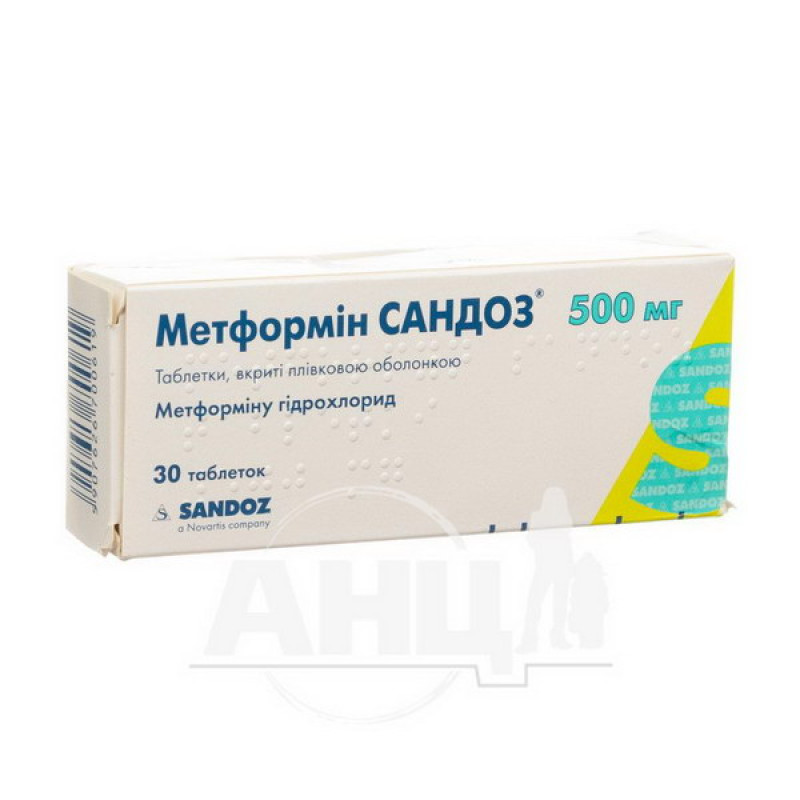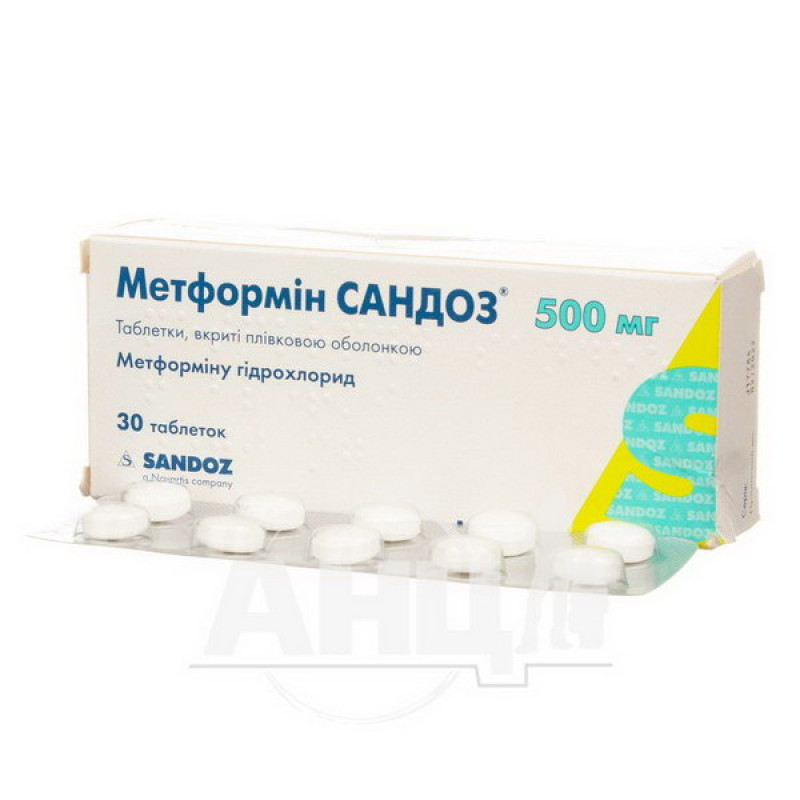Metformin Sandoz film-coated tablets 500 mg blister No. 30

Pharmacological properties
Pharmacodynamics. Metformin belongs to the biguanide group of antidiabetic drugs. The mechanism of action is associated with the drug's ability to inhibit gluconeogenesis. Metformin increases the sensitivity of peripheral receptors to insulin and stimulates glucose uptake by myocytes. It is able to reduce both basal and postprandial blood glucose levels. It does not stimulate insulin secretion and therefore does not lead to the development of hypoglycemia. Unlike sulfonylureas, metformin does not cause a hypoglycemic effect in healthy individuals.
Metformin causes a significant reduction in body weight in obese diabetic patients. It reduces appetite, enhances anaerobic glycolysis, delays the absorption of carbohydrates in the intestine. It causes a positive effect on lipid metabolism: it reduces the level of total cholesterol, LDL and TG.
Pharmacokinetics. After oral administration of metformin, C max is reached after 2.5 hours. Metformin is absorbed in the gastrointestinal tract almost completely, 20-30% of the dose is determined in the feces. The absolute bioavailability of metformin is about 50-60% in healthy individuals.
When using the recommended doses and the usual dosing interval, steady-state plasma concentrations are reached within 24-48 hours and are 1 μg/ml. C max did not exceed 4 μg/ml even after using maximum doses of metformin. Food intake reduces and slows down the absorption of metformin. Binding to plasma proteins is insignificant.
Metformin is excreted unchanged in the urine, metabolites have not been identified to date. Renal clearance of metformin is about 400 ml/min, indicating active tubular secretion. T ½ is approximately 9-12 hours. In renal impairment, renal clearance decreases in proportion to creatinine clearance, so T ½ is prolonged and metformin plasma concentrations increase.
Indication
Type 2 diabetes mellitus (insulin-dependent) in adults with ineffective diet therapy (especially in obese patients).
Type I diabetes mellitus in combination with insulin.
Application
The dose of the drug is set by the doctor individually depending on the blood glucose level.
The initial dose for adults is 500-1000 mg/day. After 10-15 days, the dose of the drug can be gradually increased depending on the blood glucose level. The maintenance dose of the drug is usually 1500-2000 mg/day. The maximum dose is 3000 mg. To reduce the severity of side effects from the gastrointestinal tract, the daily dose should be divided into 2-3 doses.
The tablets should be taken without chewing during or after meals.
The duration of treatment is determined by the doctor depending on the severity and course of the disease.
Combination with insulin
To achieve better blood glucose control, metformin and insulin can be combined. Metformin is prescribed in the usual dose - 1 tablet of 500 mg 2-3 times a day, and the dose of insulin depends on the established blood glucose levels.
Elderly patients
In elderly patients, the dose of metformin depends on the functional state of the kidneys, which requires regular monitoring.
To make it easier to take 850 mg tablets, they can be divided into 2 parts, but both halves should be taken immediately one after the other.
To divide the tablet, place it on a hard surface with the convex side up and press simultaneously on both parts, on the right side and to the left of the crescent notch.
Contraindication
Hypersensitivity to the active substance or to any of the components of the drug. diabetic ketoacidosis, diabetic precoma, coma; renal impairment (creatinine clearance 60 ml/min); acute diseases with a risk of developing kidney dysfunction (dehydration (with diarrhea, vomiting), fever, severe infectious diseases, hypoxic conditions (shock, sepsis, kidney infections, bronchopulmonary diseases), pronounced clinical manifestations of acute and chronic diseases that can lead to the development of tissue hypoxia (heart or respiratory failure, acute myocardial infarction, etc.), severe surgical operations and injuries (when insulin therapy is appropriate), impaired liver function, chronic alcoholism, acute alcohol poisoning, lactic acidosis (including a history), use at least 2 days before and within 2 days after radioisotope or X-ray examinations with the introduction of iodine-containing contrast agents, adherence to a hypocaloric diet (1000 kcal / day). pregnancy and breastfeeding.
The drug is not recommended for use in people over 60 years of age who perform heavy physical work, which is associated with an increased risk of developing lactic acidosis.
Side effects
Frequency of adverse reactions: very common (≥1/10), common (≥1/100, 1/10), uncommon (≥1/1000, 1/100), rare (≥1/10,000, 1/1000), very rare (1/10,000) and isolated cases.
Metabolic: rarely - with prolonged treatment - hypovitaminosis B12 (impaired absorption). This should be taken into account in patients with megaloblastic anemia; very rarely - lactic acidosis (requires discontinuation of treatment).
Hepatobiliary disorders: isolated reports of liver dysfunction or hepatitis, which resolved after metformin discontinuation.
From the hematopoietic system: in some cases - megaloblastic anemia.
Skin: very rarely - erythema, itching, urticaria, rash.
Other: taste disturbance.
Special instructions
Lactic acidosis is a rare and severe metabolic complication caused by metformin accumulation. In general, cases of lactic acidosis occur in patients with diabetes mellitus, in patients with severe renal failure who took metformin. The degree of manifestation of lactic acidosis can and should be reduced, taking into account such risk factors as uncontrolled diabetes mellitus, ketonemia, fasting, excessive alcohol consumption, liver failure and conditions associated with hypoxia.
Lactic acidosis is characterized by acidotic dyspnea with subsequent decrease in body temperature and coma. Diagnostic indicators include low blood pH, plasma lactate level of 5 mmol / l, increased lactate / pyruvate ratio. At the first signs of lactic acidosis, metformin should be immediately discontinued and a doctor consulted.
Since metformin is excreted by the kidneys, it is necessary to determine the level of creatinine in the blood serum before starting treatment and monitor it at regular intervals:
at least once a year in patients with normal renal function; however, 2-4 times a year in patients with serum creatinine levels above normal, as well as in elderly patients.Decreased kidney function is most often observed in elderly patients.
Particular caution is required in cases of possible renal impairment (e.g. at the beginning of therapy with antihypertensive agents or diuretics, during NSAID therapy).
Metformin should be discontinued 48 hours before and within 48 hours after radioisotope or X-ray examinations with the administration of an iodinated contrast agent.
Metformin should be discontinued 48 hours before surgery with general anesthesia. Therapy may be resumed no earlier than 48 hours after surgery.
Incompatible with alcohol.
During treatment with metformin, patients should follow a diet. Overweight patients should follow a low-calorie diet.
In patients with diabetes, it is necessary to regularly monitor blood glucose levels.
Metformin does not cause hypoglycemia, although caution is recommended when used in combination with insulin or sulfonylureas.
The film coating of the tablets contains lactose, therefore the drug should not be used in patients with rare hereditary forms of galactose intolerance, lactase deficiency or glucose-galactose malabsorption syndrome.
Children. The drug is not used in children.
Pregnancy and breastfeeding. The drug is not used during pregnancy and breastfeeding.
Breastfeeding should be discontinued during treatment with metformin.
Ability to influence the reaction rate when driving vehicles or working with other mechanisms. Monotherapy with metformin does not lead to hypoglycemia and therefore does not affect the ability to drive vehicles and other mechanisms. However, patients should be informed about the risk of hypoglycemia when using metformin in combination with other antidiabetic drugs (insulin, sulfonylureas, repaglinide).
Interactions
Simultaneous administration of danazol is not recommended to avoid the hyperglycemic effect of the latter. If treatment with danazol is necessary and after discontinuation of the latter, the dose of metformin should be adjusted under the control of glycemia.
Alcohol consumption increases the risk of lactic acidosis during acute alcohol intoxication, especially in cases of fasting or low-calorie diet, and in cases of liver failure. Alcohol and alcohol-containing medications should be avoided while taking the drug.
Combinations that require special caution
Chlorpromazine: when taken in high doses (100 mg/day) increases glycemia, reducing insulin release. During treatment with neuroleptics and after discontinuation of the latter, metformin dose adjustment is required under glycemic control.
Beta-adrenergic antagonists, ACE inhibitors, MAO inhibitors, nonsteroidal anti-inflammatory drugs, clofibrate derivatives, oxytetracycline, cyclophosphamide and its derivatives may enhance the hypoglycemic effect of metformin.
Mammary and ectopic drugs, adrenaline and other sympathomimetics, glucagon, thyroid hormones, phenothiazines, thiazide diuretics, nicotinic acid derivatives reduce the severity of the hypoglycemic effect of metformin.
Systemic and local glucocorticosteroids reduce glucose tolerance, increase glycemia, sometimes causing ketosis. In the treatment of GCS and after discontinuation of the latter, metformin dose adjustment is required under the control of glycemia.
Diuretics: Concomitant use of loop diuretics may lead to lactic acidosis due to possible renal failure. Metformin should not be prescribed if the plasma creatinine level exceeds 135 μmol/L in men and 110 μmol/L in women.
Iodinated radiopaque agents: radiological studies using radiopaque agents may cause the development of lactic acidosis in patients with diabetes mellitus on the background of functional renal failure (see Features of use).
Use of β 2 -adrenoceptor agonists in the form of injections: glycemia increases due to stimulation of β 2 -adrenoceptors. In this case, glycemia control is necessary. If necessary, insulin administration is recommended.
With the simultaneous appointment of metformin with sulfonylurea derivatives, insulin, acarbose, salicylates, its hypoglycemic effect may be enhanced.
Overdose
Hypoglycemia when using metformin at a dose of 85 g was not noted, even if lactic acidosis developed under these conditions. Early signs of lactic acidosis are nausea, vomiting, diarrhea, fever, abdominal and muscle pain; later, rapid breathing, dizziness, impaired consciousness and the development of coma are possible.
Treatment: at the first signs of lactic acidosis, metformin treatment should be discontinued, the patient should be hospitalized immediately and, having determined the lactate concentration, the diagnosis should be clarified. The most effective method of removing lactate and metformin from the body is hemodialysis. Therapy is symptomatic.
Storage conditions
At a temperature not exceeding 25 °C.
There are no reviews for this product.
There are no reviews for this product, be the first to leave your review.
No questions about this product, be the first and ask your question.






